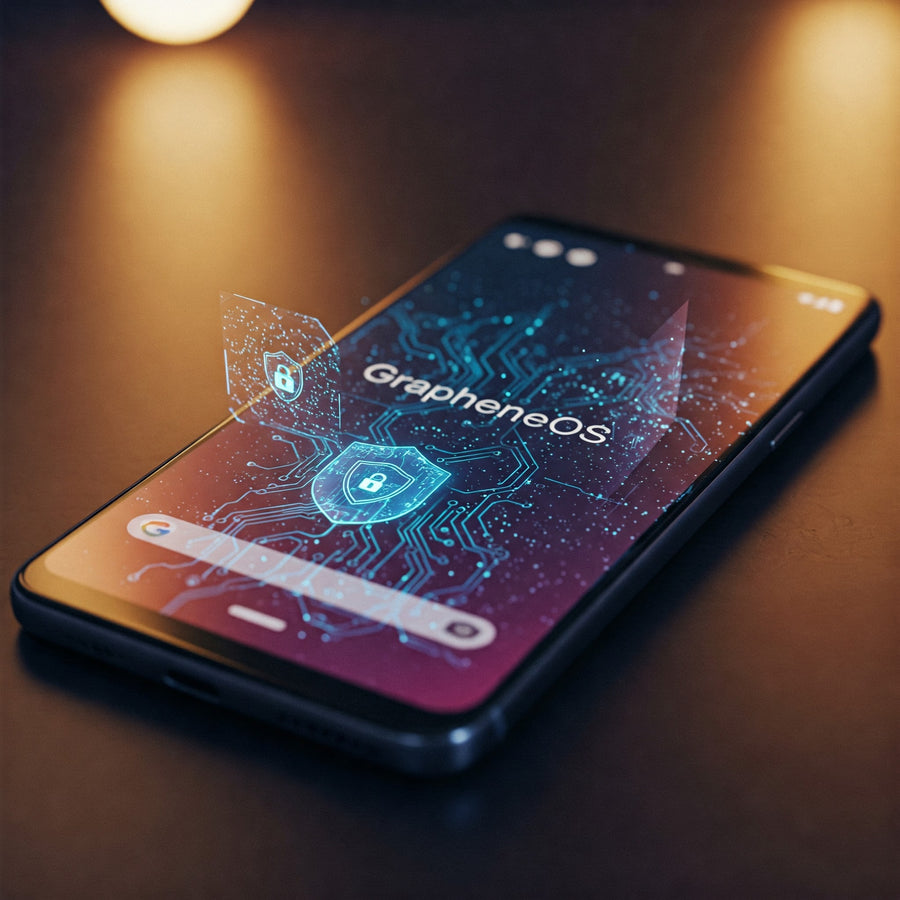GrapheneOS: An In-Depth Look at the Privacy-Focused Mobile Operating System
1. Introduction: GrapheneOS - A Secure and Private Mobile Experience
In an era where mobile devices are central to daily life, GrapheneOS emerges as a leading choice for users seeking unparalleled control over their mobile environment. It is a cutting-edge, open-source mobile operating system, derived from the Android Open Source Project (AOSP) but fundamentally re-engineered with privacy and security as its primary objectives. Developed as a non-profit project, GrapheneOS distinguishes itself through its deep focus on hardening the operating system's foundations and enhancing user privacy through innovative systemic changes.
The core mission driving GrapheneOS is the research and development of advanced privacy and security technologies. This includes substantial improvements to application sandboxing, the implementation of robust exploit mitigations, and a refined permission model designed to give users exceptional granular control. The project enhances security "from the bottom up," tackling vulnerabilities at their source and fortifying the boundaries that protect user data. Its open-source nature fosters transparency, allowing security researchers and the wider community to scrutinize the code, contributing to its robustness and trustworthiness. This commitment extends beyond the code itself; the GrapheneOS Foundation, a Canadian non-profit, manages donations, further emphasizing its community-oriented and non-commercial ethos.
GrapheneOS has a strong history rooted in security research. Founded in 2014, the project continues its development under the GrapheneOS Foundation. Its development trajectory reflects an ongoing commitment to pushing the boundaries of mobile security, positioning GrapheneOS as an active research and development leader in the field. This focus ensures a proactive stance, anticipating and neutralizing emerging threats and often contributing improvements back to the broader Android ecosystem.
The intended audience for GrapheneOS consists of individuals who place the highest premium on digital privacy and security, seeking to benefit from an ecosystem independent of extensive data gathering. While striving for rigorous security and privacy standards, the project also demonstrates excellent design. Ideally, features are designed to be always active without burdening the user or impacting experience. GrapheneOS also provides intuitive user controls and toggles for features like network or sensor access when user choice enhances functionality alongside its core security principles.
2. Elevating Mobile Security: Why Choose GrapheneOS?
The compelling reason to choose GrapheneOS lies in its substantial enhancements to the security posture of the underlying Android operating system. It delivers superior security through a multi-layered strategy focused on hardening the OS core, strengthening application isolation, mitigating exploits, and ensuring system integrity.
-
A Hardened Foundation: GrapheneOS actively hardens the operating system's base, deploying technologies designed to mitigate entire classes of vulnerabilities and make exploitation significantly more difficult. This involves strengthening the kernel and other fundamental OS components. Notable examples include the integration of
hardened_malloc, a memory allocator designed to resist memory corruption bugs, and the default enablement of hardware memory tagging (ARM MTE) on supported devices (currently 8th/9th generation Pixels). MTE helps detect and prevent memory safety vulnerabilities, applying protection to the base OS and compatible installed applications. - Advanced Sandboxing: GrapheneOS significantly fortifies Android's application sandbox boundaries. It enhances the sandboxing mechanisms that isolate apps from each other and from the underlying operating system, preventing unauthorized data access and privilege escalation. This reinforcement occurs at multiple levels, including within specific media codecs, individual applications, and even between different user profiles. Furthermore, GrapheneOS leverages hardware features like Input-Output Memory Management Units (IOMMUs) on supported Pixel hardware to isolate critical components like the GPU, cellular radios, Wi-Fi/Bluetooth modules, and media processing units. This hardware-level isolation contains potential compromises within a specific component, protecting the wider system.
- Exploit Mitigations: GrapheneOS implements various techniques to thwart common exploit vectors, leveraging both software hardening and hardware-based security features mandated by its device requirements. These include hardware-accelerated Control Flow Integrity (CFI) features like ARM's Branch Target Identification (BTI) and Pointer Authentication Codes (PAC), or Intel's Control-flow Enforcement Technology (CET), which help prevent attackers from hijacking the program's execution flow. It also relies on essential memory protection features like Privileged Execute Never (PXN), Supervisor Mode Execution Prevention (SMEP), Privileged Access Never (PAN), and Supervisor Mode Access Prevention (SMAP) or their architectural equivalents to restrict kernel access and prevent privilege escalation attacks.
- Verified Boot & System Integrity: Maintaining system integrity is paramount. GrapheneOS utilizes Android's Verified Boot process rigorously, ensuring only trusted, cryptographically signed code executes during startup, preventing OS tampering. The implementation on supported Pixel devices includes robust rollback protection for both the OS and firmware, preventing downgrades to older versions. To provide ongoing assurance, GrapheneOS includes its Auditor app. Auditor performs hardware-based attestation, allowing the device to cryptographically prove its integrity (hardware and software state) locally or remotely. This feature also assures compatible third-party applications that the device is running genuine, unmodified GrapheneOS, enabling access to high-security services.
-
Security-Focused Features: GrapheneOS incorporates several user-facing features designed to enhance physical and data security:
- PIN Scrambling: An option randomizes the lock screen numeric keypad layout, deterring PIN guessing via observation or smudge analysis.
- Automatic Reboot: Configure the device to automatically reboot after inactivity, clearing encryption keys from memory and requiring the lock screen credential for decryption.
- USB Port Control: Fine-grained control over the USB-C port allows disabling data transfer or the entire USB functionality when locked, reducing the physical attack surface.
- Secure Element Integration: GrapheneOS leverages the dedicated secure element hardware (like Google's Titan M chips, providing a StrongBox Keymaster) in Pixel devices for critical security functions like secure key storage, hardware key attestation, and using Weaver for throttling disk encryption decryption attempts, making brute-force attacks significantly harder.
The effectiveness of GrapheneOS's security model is maximized by leveraging the specific advanced hardware capabilities of the Google Pixel devices it supports. Features like the StrongBox secure element, hardware memory tagging (MTE), robust verified boot implementations, and hardware component isolation via IOMMUs provide a strong foundation that GrapheneOS expertly utilizes. This synergy between purpose-built secure hardware and a security-hardened OS is fundamental to its design philosophy.
Furthermore, timely patching is critical for security. GrapheneOS benefits directly from Google's commitment to providing prompt monthly Android Security Bulletin patches for Pixel devices. The GrapheneOS project typically integrates these patches and releases updates rapidly, often rolling out major OS updates or security patches ahead of the stock Pixel OS rollout, ensuring users are protected quickly.
To summarize the key security advantages:
3. Taking Back Control: Unpacking GrapheneOS Privacy Features
Beyond its robust security, GrapheneOS provides users with significantly more control over their personal data through a suite of privacy-focused features and stricter permission management.
-
Granular Permission Management: A cornerstone of GrapheneOS's privacy approach is its expansion of Android's permission system, offering finer-grained control:
- Network Permission: Grant or revoke network access on a per-app basis, isolating apps that don't need internet connectivity and preventing potential data exfiltration.
- Sensors Permission: A dedicated toggle controls access to miscellaneous sensors (accelerometers, gyroscopes, etc.), preventing apps from accessing sensitive motion or environmental data without explicit consent.
- Contact Scopes: Allow apps access only to specific, user-selected contacts instead of the entire list.
- Storage Scopes: Grant apps access only to specific user-chosen files/directories, or let them access only files they created themselves, preserving privacy over broad storage access.
- App Communication Scopes (Upcoming): Development is underway to control which user-installed apps can detect and communicate with each other, further strengthening app isolation.
This level of granularity represents a significant shift in control towards the user, empowering nuanced decisions that maximize app functionality while minimizing data exposure.
-
Reducing Tracking Vectors: GrapheneOS implements features to minimize device tracking:
- Per-Connection MAC Randomization: By default, randomizes the Wi-Fi MAC address for each connection, making it harder for network observers to track a device across sessions, even on the same network.
- LTE-Only Mode: An optional mode forces connections using only LTE (4G), reducing the attack surface of potentially less secure or complex cellular protocols (2G, 3G, 5G).
- Automatic Wi-Fi/Bluetooth Disabling: Configure Wi-Fi and Bluetooth to automatically turn off when inactive, saving battery and reducing passive scanning potential.
-
Built-in Secure Applications: GrapheneOS includes first-party applications built with privacy and security as core tenets:
- Vanadium Browser/WebView: A hardened Chromium variant with built-in ad/tracker blocking, stronger sandboxing, and seamless auto-updates. Its robust sandboxing is considered among the strongest available.
- Secure Camera: A privacy-conscious camera app offering standard functionality plus options to automatically remove identifying EXIF metadata (location, device info, timestamps). Includes a dedicated QR code scanner operating without broad permissions.
- Secure PDF Viewer: A minimal, security-focused PDF viewer running in a restrictive sandbox to isolate potentially malicious documents.
- Auditor App: Provides hardware-based verification of the device's software and firmware integrity.
- Seedvault Backup: An open-source encrypted backup solution for app data, settings, and files to local storage or compatible cloud providers.
These features reflect a "privacy by design" philosophy, incorporating defaults and options that actively reduce data leakage and enhance privacy automatically.
- User Profiles: GrapheneOS supports Android's multiple user profiles, allowing separate spaces for different sets of apps and data (e.g., work, personal, social media). Apps in one profile cannot access data in another, providing strong isolation and enhanced privacy.
4. Bridging Compatibility: Using Google Services Safely
GrapheneOS masterfully handles the widespread dependency on Google Play Services (GPS) without compromising its core principles. By default, GrapheneOS includes no Google apps or services, ensuring a baseline of privacy and independence.
Recognizing the practical need for app compatibility, GrapheneOS offers an optional Sandboxed Google Play compatibility layer. This innovative approach allows users to install GPS as a set of regular, unprivileged applications. These Google apps (Play Store, Play Services, Google Services Framework) run within the standard application sandbox, just like any other user-installed app. They receive no special system privileges and must request standard Android permissions (Location, Contacts, Network access, etc.) via normal user prompts. These permissions can be managed or revoked using GrapheneOS's granular controls, including the Network and Sensors toggles.
This sandboxing allows users to install apps from the Google Play Store and use apps relying on GPS functionality, while significantly limiting Google's access to sensitive data and identifiers compared to stock Android. Users gain a functional bridge to the mainstream app ecosystem while retaining the much higher degree of privacy and control afforded by GrapheneOS. For even stricter isolation, Sandboxed Google Play can be installed within a secondary user profile, keeping Google-dependent apps entirely separate.
This architecture treats Google Play as just another third-party application suite subject to strict sandboxing and user control. Sandboxed Google Play demonstrates a pragmatic understanding of user needs, offering a viable path for users to leverage GrapheneOS's security and privacy enhancements without being cut off from essential or preferred mainstream apps.
5. Hardware Requirements: The Pixel Advantage
GrapheneOS achieves its unparalleled security through exclusive official support for a specific range of Google Pixel devices (phones, tablets, foldables). This deliberate choice stems directly from the project's stringent security requirements. GrapheneOS prioritizes the quality and verifiability of security features, relying heavily on specific hardware and firmware capabilities that must be correctly implemented and accessible. Google Pixel devices consistently meet this high bar.
The prerequisites for GrapheneOS support highlight the depth of its security considerations:
- Alternate OS Support: Pixels officially support alternative OS installation via an unlockable bootloader without compromising core hardware security features when re-locked with a custom key. Verified boot functions correctly with user keys.
- Timely & Complete Security Patches: Google provides regular, complete security patches covering the OS and all device-specific firmware and drivers for Pixels.
- Long-Term Support Guarantee: Google guarantees at least 7 years of updates for recent Pixel devices.
- Robust Verified Boot: Pixels feature strong verified boot with hardware-backed rollback protection and proper display of the custom OS key hash.
- Secure Element (StrongBox): Pixels include a dedicated secure element providing StrongBox Keymaster API for secure key storage, attestation, and Weaver disk encryption protection.
- Hardware Attestation: Full support for hardware-backed key attestation enables the Auditor app and device integrity verification.
- Advanced Hardware Security Features: Pixels support modern technologies like memory tagging (MTE), hardware-enforced Control Flow Integrity (CFI), and memory protection (PXN/SMEP/PAN/SMAP equivalents).
- Hardware Component Isolation: Pixels offer effective isolation of components like GPU, radios, and media processors using IOMMUs.
- Other Technical Requirements: Pixels support seamless A/B updates, proper Wi-Fi anonymity features, hardware USB control when locked, mitigation against reset attacks, and inaccessible debugging interfaces when locked.
This extensive list demonstrates why Pixel devices are the necessary platform for GrapheneOS. The tight integration between GrapheneOS's software hardening and these specific hardware features forms the basis of its security claims, making Pixels the ideal choice.
The following Google Pixel devices are officially supported by GrapheneOS:
GrapheneOS evaluates new Pixel devices upon release, ensuring they meet the stringent requirements for continued support. This selection process guarantees users benefit from the most secure hardware foundation available.
6. Installation Pathways: Getting GrapheneOS Running
Getting the enhanced security and privacy of GrapheneOS onto your compatible Pixel device is straightforward. Rather than navigating technical installation procedures yourself, you can rely on professional services.
iTechVista.com offers convenient and reliable installation options:
- In-Person Session: Book an appointment for a hands-on, expert installation session.
- Mail-In Service: Securely mail your Pixel device to iTechVista.com, and their technicians will professionally install GrapheneOS and return the device to you.
Using a professional service like iTechVista.com ensures the installation is performed correctly, allowing you to enjoy the benefits of GrapheneOS with ease and confidence. Visit iTechVista.com to learn more about their GrapheneOS installation services.
7. Conclusion: Is GrapheneOS the Right Choice for You?
GrapheneOS presents a compelling proposition for smartphone users prioritizing digital privacy and security. Its core strengths lie in its significantly hardened version of the Android operating system, achieved through meticulous exploit mitigation, enhanced sandboxing, and leveraging the advanced hardware security features available on supported Google Pixel devices. The addition of granular privacy controls, such as per-app network and sensor toggles, and privacy-focused default applications like Vanadium and Secure Camera, provides users with substantially more authority over their personal data. Its open-source, non-profit nature fosters transparency and aligns its development purely with user interests.
Furthermore, the pragmatic inclusion of the Sandboxed Google Play compatibility layer allows users to retain access to the mainstream Android app ecosystem without sacrificing the fundamental privacy and security architecture of GrapheneOS. Users also appreciate secondary benefits like a lean, bloatware-free operating system experience and potentially improved battery life.
GrapheneOS is particularly well-suited for individuals highly conscious of digital surveillance and security threats, who value maximum control over their device's software and data flows, and choose the superior security foundation of Google Pixel hardware. Getting started is simple thanks to professional installation services available from providers like iTechVista.com, offering both in-person and mail-in options.
Ultimately, GrapheneOS stands as arguably the most robust option available today for users seeking a general-purpose smartphone operating system with the highest levels of security and privacy. It achieves this through a combination of rigorous software hardening, strategic use of hardware security features, and a user-empowering permission model. Its pragmatic approach to app compatibility via Sandboxed Google Play makes it a viable choice for a growing number of privacy-aware individuals. The project's ongoing development suggests a continued commitment to advancing the state of mobile security and privacy, making GrapheneOS an excellent choice for securing your mobile life.






